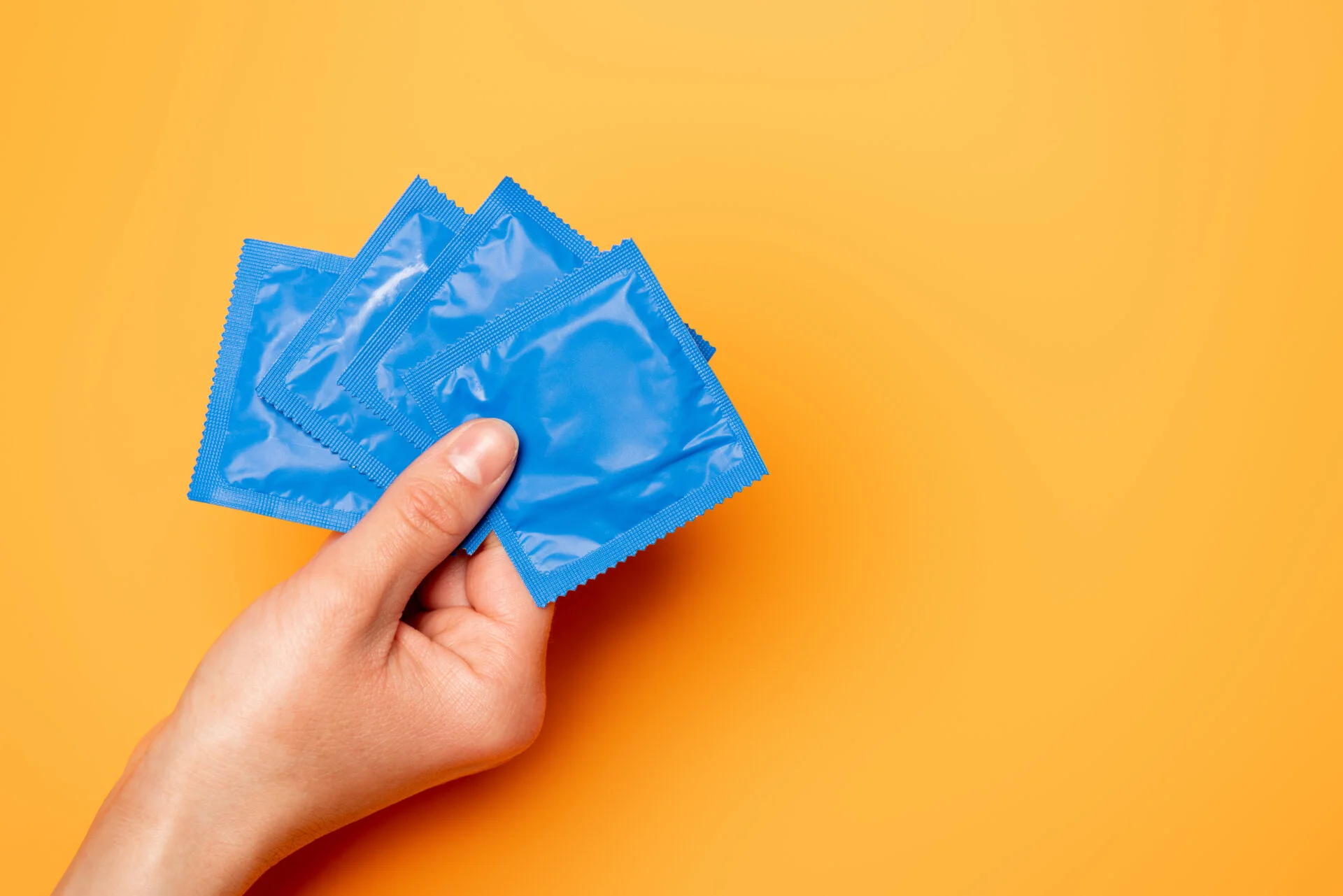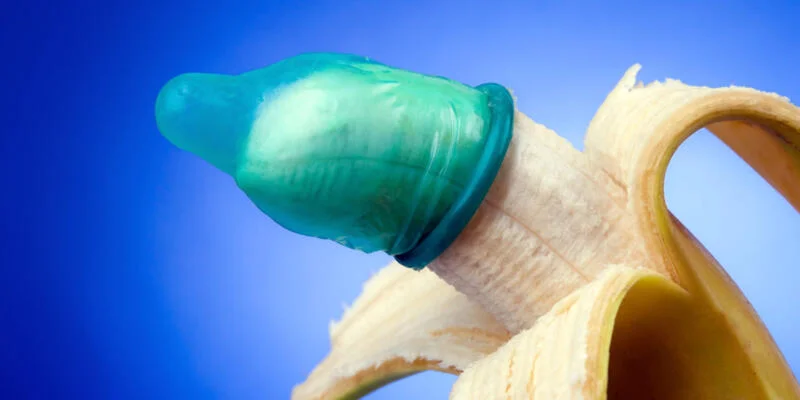What are the safest condoms and lubricants without indications of PFAS “forever chemicals?” This was the question Mamavation members asked us because they were concerned about these products for their own personal health, but also for the young adults & teenagers in their lives. We did not know the answer to these questions because no one has studied the impacts of PFAS in this category of reproductive health products yet, so we decided to start testing. Would you like some guidance on the safest condoms and lubricants? You’ve trusted Mamavation to bring you safest makeup sans PFAS, safest contact lenses, best water purifiers to filter PFAS, and best organic mattresses, now join us for a consumer study on condoms & lubricants with raw laboratory results on PFAS “forever chemical” indicators.
Disclosure: This consumer study is released in partnership with Environmental Health News. Scientific reviews were performed by (1) Terrence Collins, Teresa Heinz Professor of Green Chemistry & Director of the Institute for Green Sciences at Carnegie Mellon University, (2) Linda S. Birnbaum, Scientist Emeritus and Former Director of the National Institute of Environmental Health Sciences and National Toxicology Program & Scholar in Residence at Duke University, Adjunct Professor at the University of North Carolina, & Yale University, & (3) Scott Belcher, Associate Professor with the Center for Environmental & Health Effects of PFAS at North Carolina State University. This post was medically reviewed by Sondra Strand, RN, BSN, PHN. Donations were provided by Environmental Health News and Mamavation community members. Note that Mamavation has only “spot-checked” the industry and thus we cannot make predictions about brands and products that we have not tested. Products and manufacturing aides can change without notice so buyer beware. This post contains affiliate links, with some to Amazon, which means Mamavation will receive a portion of those sales and we will use that to pay ourselves back for the testing. You can also give a tax-deductible donation to our consumer studies here through Environmental Health Sciences. Thank you! [Updated: Additional products added on 5-8-2024]

Table of Contents
Mamavation’s Lab Finds Indications of PFAS “Forever Chemicals” In Condoms & Lubricants
Mamavation’s EPA-certified laboratory found indications of PFAS “forever chemicals” after analyzing 29 popular condoms & lubricants on the market today. PFAS are per- and polyfluoroalkyl substances that have been used for many decades as stain-resistant, oil-resistant, grease-resistant, & water-resistant chemicals in commerce. From our vantage point, it looks as if the condom & lubricant industry may have some contamination issues from manufacturing, which is commonplace in other industries.
PFAS is found in many other areas of our homes with some examples being cookware, makeup, drinking water, contact lenses & dental floss. These chemicals are linked to serious health effects, which we will discuss later. Because PFAS are so toxic, Mamavation has commissioned our own scientific studies on indications of PFAS in products to make recommendations for condoms & lubricants using PFAS-free materials. Read Mamavation’s articles on these products to find which brands are organic-fluorine-free.
For this consumer study, Mamavation sent 25 condoms & 4 lubricants from 19 brands to an EPA-certified laboratory looking for indications of toxic PFAS “forever chemicals.” Here’s what we found:
- 14% of total condom & lubricants tested had indications of PFAS “forever chemicals.” 4 detections from 29 reproductive health products (condoms & lubricants) had organic fluorine above 10 parts per million (ppm) according to our lab,
- Broken down by category, 12% of condoms tested had indications of PFAS “forever chemicals.” Specifically, 3 out of 25 condoms had detectable levels of organic fluorine above 10 ppm.
- 25% of lubricants had indications of PFAS “forever chemicals.” Specifically, 1 out of 4 lubricants had detectable levels of organic fluorine above 10 ppm.
- Ranges of organic fluorine, a marker of PFAS, were from 13 ppm to 68 ppm.
Linda Birnbaum, Scientist Emeritus and Former Director of the National Institute of Environmental Health Sciences and National Toxicology Program & Scholar in Residence at Duke University, and Adjunct Professor at both University of North Carolina, & Yale University had this to say: “Because condoms are an exposure to the most sensitive areas on the human body for both men and women, I would strongly recommend the industry identify and remove these chemicals immediately. The vagina and penis are incredibly vascular areas and dermal exposure to these areas are often higher than other places of the body.”
[Update: Additional lubrication products added on 5-8-2024 to bring consumers more “clean” options.]
PFAS “Forever Chemicals” Have Problematic Health Effects
PFAS “forever chemicals” are problematic for human health and the environment. They are considered ubiquitous, persistent, and toxic. In fact, many of these PFAS chemicals can last for years or decades in our bodies. The health effects from exposure to PFAS inside the vagina and penis areas are unknown. However, we do know that these are some of the most vulnerable areas of the human body to the effects of toxic chemicals like PFAS in the environment. Therefore, it’s imperative to reduce the amount of PFAS you are exposed to from food, water, and consumer products like condoms and lubricants. Mamavation is dedicated to helping you do that when you are shopping for condoms and lubricants.
Here are some of the health effects of different PFAS “forever chemicals:”
- Reduction in immunity
- Reduced vaccination response
- Increased risk of allergies & asthma in young children
- Affected growth, learning, and behavior of infants and older children
- Increase cholesterol levels
- Metabolic diseases like obesity & diabetes
- Cardiovascular disease
- Lowered a woman’s chance of getting pregnant
- Lowered male fertility
- Increased risk of kidney & testicular cancers
- Causes endocrine disruption
- Disrupted normal thyroid function
- Increases risk of acute lymphoblastic leukemia in children
It’s also very clear based on biomonitoring evidence from the Center for Disease Control (CDC) that PFAS are in all Americans. Therefore, these impacts can harm most Americans.
Terrence Collins, Teresa Heinz Professor of Green Chemistry & Director of the Institute for Green Sciences at Carnegie Mellon University had this to say: “We live in a highly chemicalized world where for 30 years environmental health scientists have been finding that a class of chemicals, called endocrine disrupting chemicals (EDCs), can impact living things adversely at trace exposures at all stages of life. It makes sense chemically that the chemicals in condoms will be absorbed into male and female reproductive tissues such as to perhaps be present in sperm and eggs at the time of fertilization. I applaud those manufacturers of condoms who are upfront about what chemicals are in their products, both the plastics and the lubricants. But much too little is known about the endocrine activities of the disclosed chemicals. While the purpose of condoms is to block fertilization, it is chemically certain that the female reproductive tract will be contaminated by some of the chemicals in condoms. Therefore, we must expand safety testing to assess these possibilities.”

Latex Gloves Are Known to Possibly Contain PFAS “Forever Chemicals” & Other Contamination Issues
When we started looking into the possibilities of how latex condoms could become contaminated with PFAS, we immediately found information about latex gloves and the techniques of proper PFAS sampling. Several university sites have instructions on how to sample PFAS within the community. In fact, right here in the instructions from Michigan PFAS Action Response Team with the State of Michigan is instructions on how to sample PFAS while avoiding contamination. They specifically say that latex gloves are known to contain PFAS. It’s recommended that you use powderless nitrile gloves instead if you want to avoid cross contamination. In our study, we were not able to interview any condom manufacturers to ascertain if latex condoms were similar to latex gloves in that reguard, but there is always this possibility.
Other ways that PFAS may be finding their way into condoms may be from manufacturing equipment, processing aides, or the packaging itself, which we did not test.
- Packaging has been quite a problem in some of our other recent studies like green beauty makeup, butter wrappers, fast food wrappers, parchment paper, & cupcake liners.
- Additional manufacturing issues could also be a problem as well. When it comes to personal care products like toilet paper, green beauty makeup, period underwear, tampons, sanitary pads, and food, there were also problems with polytetrafluoroethylene (aka PTFE, a type of PFAS) coming from fluorinated plastic, manufacturing aides, and non-stick coatings on equipment.
Any of these possibilities could also be a reason why our laboratory found indicators of PFAS within condoms and lubricants. Ultimately, it will be up to the brands to do their own testing for total organic fluorine (TOF), identifying the problem, and removing it from the supply chain.
Other Categories of Products Mamavation Has Tested for Indications of PFAS “Forever Chemicals”
Before we launch into the raw data from our lab, we wanted to remind you about all the other studies we have done on indications of PFAS “forever chemicals” inside the food and consumer products you may bring inside your home. Each one of these studies were done in a similar fashion as this study with brands sent independently to the lab and raw data of those labs at the bottom of the post.
- Soft Contact Lenses
- Green Beauty Makeup
- Lip Balm
- Dental Floss
- Toilet Paper
- Period Underwear
- Tampons
- Sanitary Pads, Pantiliners, & Incontinence Pads
- Powdered Electrolytes
- Butter Wrappers
- Pasta & Tomato Sauces
- Nut Butters (Peanut butter, etc.)
- Cooking Oils (olive oil, almond oil, canola oil, etc)
- Ketchup
- Activewear (Yoga Pants)
- Sports Bras
- Parchment Paper
- Cupcake Liners
- Plastic-Free Straws
- Fast Food Packaging
- Children’s Probiotics
- Kids’ Backpacks
- Baby Strollers
Mamavation’s Investigation of Condoms & Lubricants
Condoms & lubricants were purchased between February and August of 2023. For this consumer study, all products were purchased by Mamavation either at Walmart or from Amazon. Each product was recorded in our database and then sent directly to the lab within it’s original packaging.
Testing: Mamavation’s EPA-certified laboratory uses marker testing to identify the potential presence of PFAS “forever chemicals” in condoms & lubricants. Organic fluorine is a marker for PFAS because all PFAS chemicals are carbon-based compounds that contain fluorine. The specific lab method used to test for total fluorine was the Determination of Total Fluorine by Oxygen Flask Combustion and Ion-Selective Electrode. If total fluorine was observed at a detection level of 10 ppm or greater, the lab did the Determination of free Fluoride Ion in the product by Ion-Selective Electrode and then subtracted that from the Total Fluorine to determine the amount of organic fluorine. This marker testing is likely to show the presence of PFAS. Organic fluorine can also capture other fluoropolymers, pharmaceuticals, and common hydrofluorocarbon refrigerants, such as 1,1,1,2-tetrafluoroethane (commonly known as R-134a) and 2,3,3,3-tetrafluoropropene (commonly known as HFO-1234yf), which are all also PFAS. None of which you want around your food, personal care products, or condoms & lubricants!
Scott Belcher, Ph.D. & Associate Professor with the Center for Environmental & Health Effects of PFAS at North Carolina State University says “fluoropolymers, such as polytetrafluoroethylene (PTFE), are extremely common forms of PFAS that could be contributing to the organic fluorine found in condoms & lubricants. Methods used for detecting individual PFAS, such as PFOA or GenX, cannot directly identify PTFE. However, the analysis of total organic fluorine (TOF) does account for all PFAS contaminants in condoms & lubricants, including PTFE. Therefore, this method of testing serves as a good ‘spot-check’ of consumer products.”
Rankings: Ranking condoms was rather difficult. We spent many months trying to get the full ingredients and materials from most of the brands to no avail. So instead of ranking the condoms via ingredients & materials for the “better” and “best” categories, we ranked them via 100% transparency instead. Our reasoning was because very few of these brands were willing to disclose 100% of the ingredients and materials, and even the ones that did disclose, we had some reservations about the ingredients used. We are not aware of studies that look at these combinations of ingredients to see if they have the possibility to disrupt hormones and impact sensitive reproductive organs and reproduction in general. Do they disrupt hormones with these combinations? We were not sure. Therefore, we gave our highest rank to the brands that disclosed 100% of their ingredients instead. We would caution you to not assume that the other brands that did not disclose have ingredients that were any better. Instead, we believe that the safest ingredients are probably residing with the brands that were the most transparent in general. As for the lubricants, we ranked them based on ingredients and the avoidance of hormone disrupting chemicals.
[Update: Additional lubrication products added on 5-8-2024 to bring consumers more “clean” options.]
Not Our Favorite Condoms & Lubricants
These condoms & lubricants were sent to an EPA-certified laboratory and the lab found detectable total organic fluorine (TOF), which indicates the possibility of containing PFAS “forever chemicals” inside.
Not Our Favorite Condoms
- Trojan Ultra Thin Condoms for Ultra Sensitivity — 13 parts per million (ppm) organic fluorine, 2nd product non-detect organic fluorine. (Ingredients & Materials: not 100% transparent)
- Union Standard Ultra Thin Lubricated Male Latex Condoms — 25 parts per million (ppm) organic fluorine, 2nd product tested 68 parts per million (ppm) organic fluorine. (Ingredients & Materials: limited transparency, Natural latex, cornstarch powder, premium medical-grade silicone lubricant.)
Not Our Favorite Lubricants
- KY Jelly Classic Water-Based Personal Lubricant — 13 ppm organic fluorine. (Ingredients: Water, Propylene Glycol, Hydroxyethylcellulose, Benzoic Acid, Carbomer, Sodium Hydroxide)
- Lola Tingling Mint Pleasure Gel for Spot-On Arousal — 39 ppm organic fluorine. (Ingredients: Dimethicone, dimethiconol, menthol) [Update: Product added to study on 5/8/2024]
- P.S. Moisturizing & Healing Hypoallergenic 100% Vegan Premium Lube Organic Aloe & Plant-Based — 25 ppm organic fluorine. (Ingredients: Organic Aloe, Green Tea Leaves, Snow Mushrooms, Quinoa Extract, Oat Grain, Farm Grown Hemp and Linseed.) [Update: Product added to study on 5/8/2024]
- uberlube Silicone Lube — 32 ppm organic fluorine. (Ingredients: Dimethicone, Dimethiconol, Cyclomethicone, Tocopheryl Acetate (Vitamin E)) [Update: Product added to study on 5/8/2024]
Better Condoms & Lubricants
Better Condoms
According to our lab, this category did not have detectable organic fluorine. When we did our due diligence on ingredients and materials and reached out to them asking for them to disclose ingredients and materials. Unfortunately, these brands were not 100% transparent with what ingredients and materials they were using either on their website or when they were asked. In other words, we don’t know what is inside these products.
- Durex Real Feel Non-Latex Regular Fit Polyisoprene Condoms — non-detect organic fluorine. (Ingredients & Materials: not 100% transparent)
- Durex Air Regular Fit Ultra Thin Condoms — non-detect organic fluorine. (Ingredients & Materials: not 100% transparent)
- Kimono Micro Thin Barely There Condoms — non-detect organic fluorine (Ingredients & Materials: limited transparency, natural rubber latex, they are lubricated with medical grade silicone oil, (polydimethylsiloxane))
- KY Me & You Condoms Extra Lubricated — non-detect organic fluorine. (Ingredients & Materials: limited transparency, natural rubber latex condom with silicone based lubricant)
- LELO HEX Original Re-engineered Latex Condoms — non-detect organic fluorine. (Ingredients & Materials: not 100% transparent)
- Lifestyles Ultra Sensitive Natural Rubber Latex Condoms — non-detect organic fluorine. (Ingredients & Materials: not 100% transparent)
- Loveability Ultra Thin Lubricated Natural Latex Condoms & Tin — non-detect organic fluorine. (Ingredients & Materials: limited transparency, Natural rubber latex (80.17%) Hypo-allergenic silicone oil (18.12%) Corn starch & magnesium carbonate powder (1.71%))
- Lovense Realsize Condom Measured for Pleasure — non-detect organic fluorine. (Ingredients & Materials: limited transparency, Natural latex, silicone lubricant)
- O Well Natural Premium Ultra Thin Latex Condoms — non-detect organic fluorine. (Ingredients & Materials: not 100% transparent)
- SKYN Feel Everything Elite Ultra Thin & Ultra Soft — non-detect organic fluorine. (Ingredients & Materials: limited transparency, Polyisoprene Lubricated Condoms are made with SKYNFEEL® material, a non-latex material)
- Trojan Bareskin Get 50% Thinner Latex Condoms — non-detect organic fluorine. (Ingredients & Materials: not 100% transparent)
- Trojan Ecstasy Ultra Ribbed “Feels like Nothing’s there!” Latex condoms — non-detect organic fluorine. (Ingredients & Materials: not 100% transparent)
- Trojan ENZ Classic Reservoir End Lubricated Latex Condoms — non-detect organic fluorine. (Ingredients & Materials: not 100% transparent)
- Trojan Her Pleasure Enhanced Stimulation for Her Latex Condoms — non-detect organic fluorine. (Ingredients & Materials: 100% transparent)
- Trojan Magnum Large Size Condoms — non-detect organic fluorine. (Ingredients & Materials: not 100% transparent)
- Trojan Naturallamb Luxury Condoms Real Skin-to-Skin — non-detect organic fluorine. (Ingredients & Materials: not 100% transparent)
- Trojan Ultra Ribbed Designed for Ultra Stimulation Latex Condoms — non-detect organic fluorine. (Ingredients & Materials: not 100% transparent)
- Wink Closer EveryDay 0.04 THIN Lubricated Male Condoms — non-detect organic fluorine. (Ingredients & Materials: limited transparency, natural latex rubber and have a Silicone/Dimethicone-based lubricant)
Better Lubricants
These lubricants did not contain any total organic fluorine according to our lab. However, they do contain some ingredients that have the possibility of disrupting hormones. Therefore, they were not put in the “best” category.
- Astroglide Water-Based Long Lasting Not sticky Personal Lubricant — non-detect organic fluorine. (Ingredients: Purified Water, Glycerin, Propylene Glycol, Polyquaternium-7)
- Good Clean Love Almost Naked Personal Lubricant — non-detect organic fluorine. (Ingredients: Organic Aloe Barbadensis Leaf Juice, Xanthan Gum, Agar, Lactic Acid, Potassium Sorbate, Sodium Benzoate, & Natural Flavor)(Recent update 2/7/24: This product has a Prop.65 warning for “non-decolorized whole leaf extract” which is a natural part of the aloe vera plant that does not have the aloin filtered out. Studies on rats found that when this chemical is added to water and ingested large intestinal tumors formed. It seems that dermal contact is not problematic. Therefore, we do not recommend ingesting this product out of precaution.)
- Signature Care (Walmart) Personal Lubricating Jelly — non-detect organic fluorine. (Ingredients: Water, Glycerin, Hydroxyethylcellulose, Chlorhexidine Gluconate, Methylparaben, Glucono Delta Lactone, Sodium Hydroxide.)
Best Condoms & Lubricants
Best Condoms
According to our lab, this category did not have detectable total organic fluorine (TOF). When we did our investigation on what ingredients and materials they were using, we either found them easily on their website or they gave it to us when we emailed them. This list consists of brands that gave us the vast majority of the chemicals and materials present inside their products. [Update: We swapped Good Clean Love in the lubricant category to the “better” section based on their Prop. 65 warning and replaced with 3 additional products that were non-detect and did not need a Prop. 65 warning.]
-
- Glyde Ultra Standard Fit Ultra Thin Condoms — non-detect organic fluorine. (Ingredients & Materials: Non-GMO natural rubber latex, Ammonia, Potassium Oleate, Potassium Hydroxide, Emulgin B2 / Vulcastab LW, Vultamol, Sulphur, Zinc Oxide, Irganox 1330 Bentonite Clay, Zinc dibutyl dithiocarbamate, Silicone lubricant, Calcium carbonate and magnesium carbonate and oat powders.)
- P.S. Good Times Exceptionally Thin Latex Condoms — non-detect organic fluorine. (Ingredients & Materials: Latex, zinc oxide (for rubber), zinc oxide (for rubber), zinc salt of di-n-buthyldithio carbamate, zinc diethyl dithiocarbamate, potassium hydroxide, sodium salt of naphthalene sulphonic acid, phenol 4-methyl-reaction products dicyclopentadiene and isobutylene, dimethylpoly siloxane, corn starch, precipitated silica.)
- Sustain Natural Ultra Thin Lubricated Latex Condoms — non-detect organic fluorine. (Ingredients & Materials: Natural Latex, Ammonia, Potassium Oleate, Potassium Hydroxide, Emulgin B2/Vulcastab, LWVultamol, Sulphur, Zinc Oxide, Zinc Di butyl Di thio Carbamate, Irganox 1330, Bentonite Clay, Silicone Lubricant, Calcium Carbonate and Magnesium Carbonate Powders)
Best Lubricant
This category represents products that did not have total organic fluorine (TOF) according to our lab. We also prefer their ingredients to the other brands we tested because they do not contain chemicals that are linked to hormone disruption or cancer. [Updated products do not need a Prop. 65 warning]
- Aloe Cadabra Personal Lubricant & Moisturizer Natural Aloe 95% organic aloe vera vitamin E enriched — non-detect organic fluorine. (Ingredients: aloe vera, vitamin E oil, xanthan, citric acid, potassium sorbate, sodium benzoate, organic vanilla planifolia concentrate.) No prop. 65 warnings are needed for this product. [Update: product added on 5/8/2024]
- Foria Awaken Arousal Oil with Organic Botanicals Intimacy — non-detect organic fluorine. (Ingredients: Organic MCT Coconut Oil, Botanical Infusions (Organically-Grown Kava Root, Organic Cinnamon, Organic Ginger, Organic Vanilla); Organic Essential Oils (Cardamom, Peppermint, Cacao Absolute)) No prop. 65 warnings are needed for this product. [Update: product added on 5/8/2024]
- Honey Pot Organic Moisturizing Lubricant Organic Strawberry Intimate — non-detect organic fluorine. (Ingredients: Water (Aqua), Tequilane Azul (Agave) Leaf Extract (Certified Organic Ingredients), Chamomilla Recutita Flower Extract (Certified Organic Ingredients), Flavor (Aroma) (Certified Organic Ingredients), Carrageenan.) No prop. 65 warnings are needed for this product. [Update: product added 5/8/2024]






 Nature Nate’s Organic Raw Honey Glyphosate & 500+ Pesticide Test Results
Nature Nate’s Organic Raw Honey Glyphosate & 500+ Pesticide Test Results
Honey Pot contains Chamomilla Recutita Flower Extract. This is one of the most allergy-inducing ingredients out there. Anyone who has a ragweed allergy (millions of people) should avoid this ingredient which is derived from the same cross-contaminating ingredient. It can induce rashes, asthma, itching, etc. Not what you want in a lubricant. Many products that use this ingredient in skincare (Honest Company, DevaCurl) have tons of reviews with well-documented issues from this ingredient. All Natural is not necessarily the safest for people who are sensitive.
are the lubricants listed suitable for use with latex and/or non-latex condoms?
making sure your lube won’t dissolve your condom is pretty important information for people who use condoms.
thank you for all your effort and for sharing this information with such clarity and transparency.
Your #1 Lubrication has “Flavor” which is an umbrella for anything the manufacturer wants to put in this product. I scanned the ingredients with my Switch Natural App and sure enough it flagged the Flavor which is considered to be toxic and not clean! Mamavation you need to get the “Switch Natural APP” and scan your product ingredients!! Here’s a clean one for ya!! Coconu Water based lubricant is 100% clean
What is the purpose of bentonite clay, which is high in lead, in two of the “best?”
Speaking of moisturizing, please do a pfas test on moisturizers. For example Vanicream, vaseline, La Roche Lipikar, etc.
What is the purpose of bentonite clay, which is high in lead, in two of the “best?”
Speaking of moisturizing, please do a pfas test on moisturizers. For example Vanicream, vaseline, La Roche Lipikar, etc.
We could have the info without the soft porn pics? SInce this is Mamavation… Most of us have kiddos running about, on our laps, etc as we view/read/learn/research.
The photos were not necessary for the information here and honestly, it would be more professionally presented and seriously taken, without those images.
These images also depict a power dynamic of women being more objectified sexually and as a mother, I am not interested in that dynamic being learned by girls or boys. The images without showing anyone’s faces are especially objectifying. Please consider taking the photos out of this or using more family friendly images.
Thank you for the work you do and thank you for your consideration.
Interesting. I had a negative reaction to the condom on a banana shot. If the editors deemed it appropriate to demonstrate a condom’s use and purpose, why not show it on an actual penis? I imagine many folks would object to this, but should a serious report on professional research need to turn to such “fruity” euphemism?
Good morning. I realize that the condoms and lubricants that tested contain PFAs. I wondering do these PFA containing items being used close to Mucus membranes( because if i remember cleaely, our bodies soak in more quickly throigh the mucosa (muscus containing areas verses jist through our pores in our skin) areas on humans have to be damaged to have exposures or do these PFAs float freely and when the condom or lubricant is put on, the PFAs is soaked in through our mucosa? Does the condom have to break before these chemicals become exposively dangerous?
Can Coconu be investigated? Thanks for all the amazing information, as always!
Ok, so, when I saw this article come through my email alerts, I was super interested, because I’m someone who does a lot of talking and working with sexual health and romance, and I was SUPER excited to see what your tests came up with! But I’m a little discouraged to see all water-based lubes in your listings, and only one non-latex condom, that I could find. Is there a reason there are so few of these products in your tests? I think a lot of people who look to your site for info are very likely to want more investigation into non-latex alternatives. I’m personally a very big advocate for silicon lube, also, and would love to see more information and research on the top products in that category.
Thanks for all you do! <3
I’m gonna take a stab in the dark and guess that the silicone based lubricants do in fact contain detectable amounts of PFAS. Don’t ask me how I know…I just know.